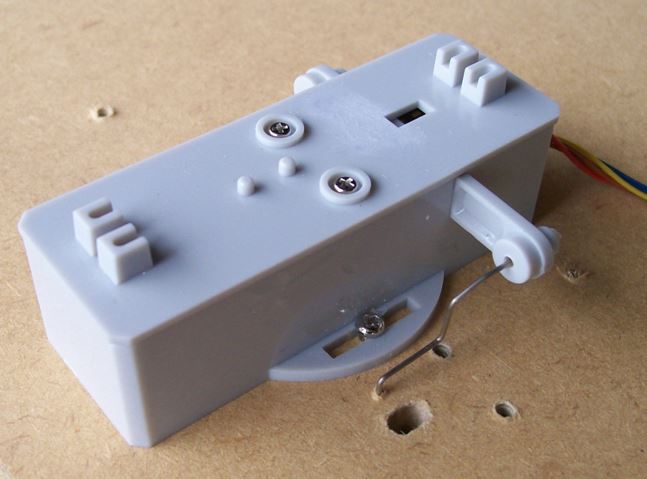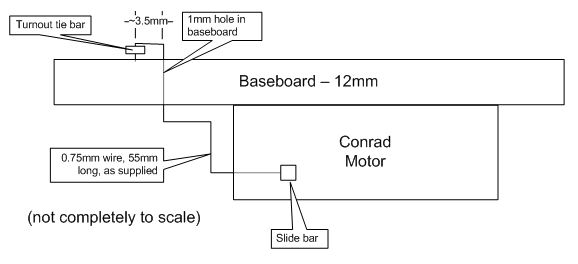Everything on model trains, model railroads, model railways, locomotives, model train layouts, scenery, wiring, DCC and more. Enjoy the world's best hobby... model railroading!
Suitability of Conrad Point Motors
David from New Zealand kindly sent in this article to share –
Description of Conrad point motors and their suitability for my N gauge layout
 I have recently returned to railway modelling after more than 50 years and I spent quite a lot of time researching the current marketplace before buying any equipment. Having decided on N gauge (N scale in USA) because of space limitations, I set up a very simple test bed with some sections of Peco track and some turnouts, both insul-frog and electro-frog.
I have recently returned to railway modelling after more than 50 years and I spent quite a lot of time researching the current marketplace before buying any equipment. Having decided on N gauge (N scale in USA) because of space limitations, I set up a very simple test bed with some sections of Peco track and some turnouts, both insul-frog and electro-frog.
One of my aims was to have ALL the turnouts motorised, and the other was to use electro-frogs except possibly where no electro-frog version of the turnout was available, e.g. Peco ST44/ST45 curved turnouts. (I discarded these in the final layout as the radii were too small). So the hunt was on for point motors which could also switch electro-frogs, and which were affordable in quantity.
There’s no getting away from the fact that the Peco point motor is designed for OO/HO. It will fit under an N gauge turnout but the movement of N gauge turnout blades is only 3mm. Therefore it is difficult to get accurate and reliable operation with N gauge, particularly when you add a microswitch unit to the motor. A Seep point motor works on the same principle and with those, the built-in frog switch only just works because of the limited turnout-blade movement.
Testing the Conrad
During my investigations I came across a couple of short videos about the Conrad point motor, so I bought a couple of motors and tested them. The basic design of the Conrad motor is to use a stiff wire directly up through the baseboard into the tie bar. This works OK with OO/HO turnouts (and probably O gauge as well, but I have no experience there) but again, it doesn’t work too well with the short travel of N gauge turnouts. However, one of the videos shows the use of a crank and I can confirm that this works brilliantly. The crank reduces the motion of the Conrad slider bar from 7mm to 3mm, and it’s easy to adjust. The Conrad motor includes a frog switch so you don’t have to buy any extra parts to operate electro-frog turnouts. I have successfully installed 31 Conrad motors on my current layout and I’m very happy with them.
How do the Conrads work?
They are based on a 12V DC motor turning a crown wheel, with a slide bar engaging the shaft of the crown wheel. They are NOT slow-acting like a Tortoise or a Cobalt motor, but they are not nearly as “violent” in action as a solenoid. Limit switches cut off the motor power at each end of the travel of the slide bar. The electrical design allows operation on AC or DC. In AC mode, the wiring is identical to that of a solenoid motor, but you can get away with a simple SPDT switch in place of a passing contact switch.
In DC mode, you use two power supplies (+12V & -12V), and here you get the greatest advantage – you only need ONE control wire plus the common return. If you don’t have a dual DC power supply, you can always use a single 12v supply and a DPDT switch to reverse the voltage supplied to the motor, but there again, you would probably use the AC method instead.
Size: The Conrad motor is 70mm long, 25mm wide (38mm over the mounting flanges), and 26mm deep. The slide bar is 47mm long overall and moves about 7mm. The shallow depth means that these motors are well suited to being used on “upper levels” where you need clearance for trains running underneath them.
The crank: The above sketch shows what I mean by the crank. I use the thicker of the two pieces of wire supplied with the motors. This is 55mm long. The hole in the baseboard serves as the pivot for the crank. The photos below illustrate this in practice – on my test-bed. You don’t need to remove the over-centre spring from the turnout. I still make an elliptical hole under each tie bar just in case I want to use a solenoid motor at a later date.
Pricing and availability
The Conrad motor (part number 1396900) is available from Conrad UK (conrad-electronic.co.uk) at £9.99, including VAT but not including shipping. Conrad UK will not ship internationally so the VAT does not come off. From Conrad.com (Germany), they are available with a quantity discount, coming down to €6.93 when the VAT has been taken off for export. The snag is that there is a €55 shipping charge, which looks horrendous. However, if you buy a quantity, the pricing comes out roughly as follows (but don’t hold me to it as rates can vary): 10 cost roughly NZ$33 each, 20 cost roughly NZ$17 each. The most you can order while staying below the NZ$400 limit is 27 or 28.
Thanks David. If you have an article you would like to share with others, please submit details to the Blog Moderator using this link http://www.model-train-layouts.net/Submit-An-Article.html


















Leave a Reply